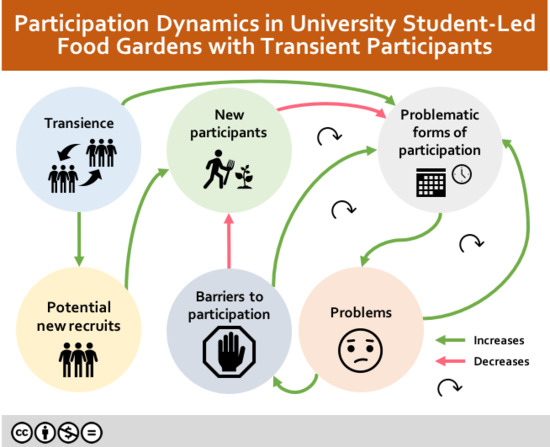Understanding Transience and Participation in University Student-Led Food Gardens
Abstract
1. Introduction
…sustainability is about passing to future generations. As students, we are, in generations, coming and leaving, and coming and leaving.Student gardener
“All it takes,” said Crake, “is the elimination of one generation. One generation of anything. Beetles, trees, microbes, scientists, speakers of French, whatever. Break the link between one generation and the next, and it’s game over forever.”Margaret Atwood, Oryx and Crake
- In addition to students’ transience, what causes short-term, irregular, and low participation in student-led food gardens?
- What effects do short-term, irregular, and low participation in student-led food gardens have?
- In student-led food gardens, what feedbacks between short-term, irregular, and low participation, their causes, and effects exist (if any)?
2. Background
2.1. Benefits of Community Gardens at Universities
2.2. Transience, Turnover, and Participation
2.3. Temporary Organisations and Transience
2.4. Systems Theory and Feedback Loops
3. Methods
- “give students (and other volunteers) the chance to learn about the ethical and environmental impact of their food choices”
- “strengthen links with the local community,” and
- provide free produce to dedicated students, and surplus produce to the wider student population at an affordable price [45].
4. Results
4.1. Causes of Short-Term, Irregular, and Low Participation
4.1.1. Barriers to ‘Getting People through the Garden Gate’
“…there is that kind of, like, that whole kind of coterie of dreadlocks and hippie kind of aesthetic. That people don’t want to be associated with.” (Student gardener)
4.1.2. Barriers to Continued Engagement
“…you can make [the garden] yours and you can decorate it. You can make it look nice. But you also have to clean it up. Like, there is some ownership. Some responsibility. […] I think that that’s super vital and that’s really powerful…” (Student gardener)
“(The garden is) a powerful form of resistance. I think sometimes people forget that. The tidal forces of the food system are so strong and so toxic. It’s just amazing that there’s anything that can withstand that. That’s important to me. You know, because, you watch something like Tomorrow’s Food and I think yeah, all the kind of tidal forces within the development of the food system are so counter to this (garden). And yet, these things still exist. A thorn in the side of people who are triumphantly, kind of, modernist.” (Student gardener) (Note: A television programme about food innovations for ‘the future of food’ (BBC, n.d.), examining, for example, the future role of vertical farming in food production and robots in food service.)
- Student gardener: “…everyone had to be vegetarian. Or vegan (…) I mean, obviously they want outsiders to join, but they don’t want outsiders to join at the same time.”
- Interviewer: “It’s almost like they want people to join, but they also want them to take on their values as well.”
- (Sound of agreement)
“How do you define this project? You know, like, where is it going? What’s the goal and stuff? I don’t know.” (Student gardener)
4.2. Effects of Low, Irregular and Short-term Participation
“…(maintaining participation was) their number one priority (…) but also something that is also taken for granted. And it’s kind of an existential crisis if they actually identify surviving as an aim.” (Former student gardener)
“It seems like, in my experience, (active students) get fed up after a year, because it’s too much responsibility. And then they never come again, after they’re no longer on the committee. Even though they did it all the time before. Sort of, like, overload. It goes both ways. You can get too much, like, involvement, just out of, like necessity, and get just not involvement because people won’t come back.” (Student gardener)
“I don’t want to tell them (the other gardeners) that I’m annoyed because then that will make them even less likely to come.” (Student gardener)
4.3. A Causal Loop Diagram to Understand Transience and Participation
“I, personally, find it difficult to see how [the maintenance of the garden] is ever going to be a sustainable situation.” (Student gardener)
5. Discussion
5.1. Strategic Points for Intervention
5.2. Learning in Student-Led Food Gardens
5.3. Methodological Reflections and Further Research Directions
6. Conclusions
Author Contributions
Funding
Acknowledgments
Conflicts of Interest
References
- Merriam Webster Online. Available online: https://www.merriam-webster.com/dictionary/transient (accessed on 25 September 2018).
- Patiniotis, J.; Holdsworth, C. ‘Seize that chance!’ Leaving home and transitions to higher education. J. Youth Stud. 2005, 8, 81–95. [Google Scholar] [CrossRef]
- Brewis, G.; Holdsworth, C.; Russell, J. Bursting the Bubble: Students Volunteering and the Community—Full Report; National Coordinating Centre for Public Engagement: Bristol, UK, 2010. [Google Scholar]
- Brewis, G.; Holdsworth, C. University support for student volunteering in England: Historical development and contemporary value. J. Acad. Ethics 2011, 9, 165–176. [Google Scholar] [CrossRef]
- Laycock Pedersen, R.; Robinson, Z. Reviewing University Community Gardens for Sustainability: Taking stock, comparisons with urban community gardens and mapping research opportunities. Local Environ. 2018, 23, 652–671. [Google Scholar] [CrossRef]
- McKinne, K.L.; Halfacre, A.C. “Growing” a campus native species garden: Sustaining volunteer-driven sustainability. Int. J. Sustain. Higher Ed. 2008, 9, 147–156. [Google Scholar] [CrossRef]
- Adrangi, M. From Campus to Community: Challenges and Opportunities of University-based Activism. Can. Dimens. 2013, 47, 33–35. [Google Scholar]
- Holton, M.; Riley, M. Student geographies: Exploring the diverse geographies of students and higher education. Geogr. Compass 2013, 7, 61–74. [Google Scholar] [CrossRef]
- Apul, D.S.; Philpott, S.M. Use of Outdoor Living Spaces and Fink’s Taxonomy of Significant Learning in Sustainability Engineering Education. J. Prof. Issues Eng. Ed. Pract. 2011, 137, 69–77. [Google Scholar] [CrossRef]
- Johnston, L.; Collins, B.L.; Boyle, A.; Womack, H.D. Looking at Sustainability through a Different LENS. Sustainability 2012, 5, 244–247. [Google Scholar] [CrossRef]
- Kobayashi, K.D.; Radovich, T.J.K.; Moreno, B.E. A Tropical Perspective on Environmental Sustainability in Horticultural Education. HortTechnology 2010, 20, 503–508. [Google Scholar] [CrossRef]
- Mundel, E.; Chapman, G.E. A Decolonizing Approach to Health Promotion in Canada: The Case of the Urban Aboriginal Community Kitchen Garden Project. Health Promot. Int. 2010, 25, 166–173. [Google Scholar] [CrossRef] [PubMed]
- Biernbaum, J.A.; Ngouajio, M.; Thorp, L. Development of a Year-round Student Organic Farm and Organic Farming Curriculum at Michigan State University. HortTechnology 2006, 16, 432–436. [Google Scholar] [CrossRef]
- Wharton, C.; Harmon, A. University Engagement through Local Food Enterprise: Community-supported Agriculture on Campus. J. Hunger Environ. Nutr. 2009, 4, 112–128. [Google Scholar] [CrossRef][Green Version]
- Fraser, J.; Gupta, R.; Krasny, M.E. Practitioners’ perspectives on the purpose of environmental education. Environ. Educ. Res. 2015, 21, 777–800. [Google Scholar] [CrossRef]
- Brookfield, S.; Fitzgerald, L. Homelessness and natural disasters: The role of community service organisations. Aust. J. Emerg. Manag. 2018, 33, 62–68. [Google Scholar]
- Steen Jacobsen, J.K. Transience and place: Exploring tourists’ experiences of place. Nordlit 1998, 1, 23–45. [Google Scholar] [CrossRef][Green Version]
- Lozanski, K.; Beres, M.A. Temporary transience and qualitative research: Methodological lessons from fieldwork with independent travelers and seasonal workers. Int. J. Qual. Methods 2007, 6, 106–124. [Google Scholar] [CrossRef]
- Walsh, J. From nations of immigrants to states of transience: Temporary migration in Canada and Australia. Int. Sociol. 2014, 29, 584–606. [Google Scholar] [CrossRef]
- Grieb, S.M.D.; Davey-Rothwell, M.; Latkin, C.A. Housing stability, residential transience, and HIV testing among low-income urban African Americans. AIDS Educ. Prev. 2013, 25, 430–444. [Google Scholar] [CrossRef]
- Eddy, B.A.; Powell, M.J.; Szubka, M.H.; McCool, M.L.; Kuntz, S. Challenges in research with incarcerated parents and importance in violence prevention. Am. J. Prev. Med. 2001, 20, 56–62. [Google Scholar] [CrossRef]
- Reed, J.; Roskell Payton, V.; Bond, S. Settling in and moving on: Transience and older people in care homes. Soc. Policy Adm. 1998, 32, 151–165. [Google Scholar] [CrossRef]
- Larkin, P.J.; De Casterlé, B.D.; Schotsmans, P. Towards a conceptual evaluation of transience in relation to palliative care. J. Adv. Nurs. 2007, 59, 86–96. [Google Scholar] [CrossRef] [PubMed]
- Mills, C.; Gale, T. Transient teachers: Mixed messages of schooling in regional Australia. J. Res. Rural Educ. 2003, 18, 145–151. [Google Scholar]
- Cornish, L. Situating practice in rural schools: Transience, adaptation and opportunity. In Innovation for Equity in Rural Education, Proceedings of the International Symposium for Innovation in Rural Education: Improving Equity in Rural Education, Armidale, Australia, 11–14 February 2009; Lyons, T., Choi, J., McPhan, G., Eds.; University of New England: Armidale, Australia, 2009; pp. 108–116. [Google Scholar]
- Starnes, B.J.; Wymer, W.W., Jr. Conceptual foundations and practical guidelines for retaining volunteers who serve in local nonprofit organizations: Part II. J. Nonprofit Pub. Sect. Mark. 2001, 9, 97–118. [Google Scholar] [CrossRef]
- Fischer, L.R.R.; Schaffer, K.B. Older Volunteers: A Guide to Research and Practice; Sage: Thousand Oaks, CA, USA, 1993. [Google Scholar]
- Hyde, M.K.; Dunn, J.; Bax, C.; Chambers, S.K. Episodic volunteering and retention: An integrated theoretical approach. Nonprofit Volunt. Sect. Q. 2016, 45, 45–63. [Google Scholar] [CrossRef]
- Christie, H. Emotional journeys: Young people and transitions to university. Br. J. Sociol. Educ. 2009, 30, 123–136. [Google Scholar] [CrossRef]
- Holdsworth, C. Between two worlds: Local students in higher education and ‘Scouse’/student identities. Popul. Space Place 2009, 15, 225–237. [Google Scholar] [CrossRef]
- Leese, M. Bridging the gap: Supporting student transitions into higher education. J. Further Higher Educ. 2010, 34, 239–251. [Google Scholar] [CrossRef]
- Bakker, R.M. Taking stock of temporary organizational forms: A systematic review and research agenda. Int. J. Manag. Rev. 2010, 12, 466–486. [Google Scholar] [CrossRef]
- Brookes, N.; Sage, D.; Dainty, A.; Locatelli, G.; Whyte, J. An island of constancy in a sea of change: Rethinking project temporalities with long-term megaprojects. Int. J. Proj. Manag. 2017, 35, 1213–1224. [Google Scholar] [CrossRef]
- Ibert, O. Projects and firms as discordant complements: Organisational learning in the Munich software ecology. Res. Policy 2004, 33, 1529–1546. [Google Scholar] [CrossRef]
- Williams, A.; Kennedy, S.; Philipp, F.; Whiteman, G. Systems thinking: A review of sustainability management research. J. Clean. Prod. 2017, 148, 866–881. [Google Scholar] [CrossRef]
- Greenwood, D.J.J.; Levin, M. Introduction to Action Research: Social Research for Social Change, 2nd ed.; Sage: Thousand Oaks, CA, USA, 2008. [Google Scholar]
- Jaradat, R.M. Complex system governance requires systems thinking-how to find systems thinkers. Int. J. Syst. Syst. Eng. 2017, 6, 53–70. [Google Scholar] [CrossRef]
- Senge, P.M. The Fifth Discipline: The Art and Practice of the Learning Organisation; Random House: London, UK, 2006. [Google Scholar]
- Meadows, D. Leverage Points: Places to Intervene in a System; The Sustainability Institute: Vermont, USA, 1999. [Google Scholar]
- Yin, R.K. Case Study Research: Design and Methods, 1st ed.; Sage: Thousand Oaks, CA, USA, 1984. [Google Scholar]
- Bryman, A. Social Research Methods, 4th ed.; Oxford University: Oxford, UK, 2012. [Google Scholar]
- Yin, R.K. Case Study Research: Design and Methods, 3rd ed.; Sage: Thousand Oaks, CA, USA, 2003. [Google Scholar]
- Hustinx, L.; Vanhove, T.; Declercq, A.; Hermans, K.; Lammertyn, F. Bifurcated commitment, priorities, and social contagion: The dynamics and correlates of volunteering within a university student population. Br. J. Sociol. Educ. 2005, 26, 523–538. [Google Scholar] [CrossRef]
- Holdsworth, C. Why volunteer? Understanding motivations for student volunteering. Br. J. Educ. Stud. 2010, 58, 421–437. [Google Scholar] [CrossRef]
- National Union of Students. Student Eats Evaluation—Baseline Survey. Student Summary Report. Available online: https://www.nus.org.uk/PageFiles/39505/Student%20Eats%20Evaluation%20-%20Baseline%20survey%20student%20summary%20report.pdf (accessed on 14 February 2019).
- National Union of Students: Student Eats—Participating Institutions. Available online: https://sustainability.nus.org.uk/student-eats/grow-your-veg/participating-institutions (accessed on 14 February 2019).
- Saldaña, J. The Coding Manual for Qualitative Researchers, 2nd ed.; Sage: London, UK, 2013. [Google Scholar]
- Howlett, S. Developing volunteer management as a profession. Volunt. Sect. Rev. 2010, 1, 355–360. [Google Scholar] [CrossRef]
- Rochester, C. A Gateway to Work: The role of Volunteer Centres in Supporting the Link between Volunteering and Employability; Institute for Volunteering Research: London, UK, 2009. [Google Scholar]
- Eizenberg, E. The changing meaning of community space: Two models of NGO management of community gardens in New York City. Int. J. Urban Reg. Res. 2012, 36, 106–120. [Google Scholar] [CrossRef]
- Laycock, R. The Tip of the Iceberg Lettuce: What Direct and Indirect Factors Enable Knowledge and Skill Sharing in Community Gardens? Master’s Thesis, Lund University, Lund, Sweden, 2013. [Google Scholar]
- Staeheli, L.A.; Mitchell, D.; Gibson, K. Conflicting rights to the city in New York’s community gardens. GeoJournal 2002, 58, 197–205. [Google Scholar] [CrossRef]
- Spierings, B.; Van Liempt, I.; Maliepaard, E. Ownership and Membership: Practices and Experiences of Neighbourhood Residents in the Wijsgeren Community Garden in Amsterdam. J. Econ. Soc. Geog. 2018, 109, 677–684. [Google Scholar] [CrossRef]
- Meyerson, D.; Weick, K.E.; Kramer, R.M. Swift trust and temporary groups. In Trust in Organizations: Frontiers of Theory and Research; Kramer, R.M., Tyler, T.R., Eds.; Sage: Thousand Oaks, CA, USA, 1996; pp. 166–195. [Google Scholar]
- Bakker, R.M.; Cambré, B.; Korlaar, L.; Raab, J. Managing the project learning paradox: A set-theoretic approach toward project knowledge transfer. Int. J. Proj. Manag. 2011, 29, 494–503. [Google Scholar] [CrossRef]
- Othman, R.; Azuan Hashim, N. Typologizing organizational amnesia. Learn. Org. 2004, 11, 273–284. [Google Scholar] [CrossRef]
- Holdsworth, C.; Quinn, J. The epistemological challenge of higher education student volunteering: “reproductive” or “deconstructive” volunteering? Antipode 2012, 44, 386–405. [Google Scholar] [CrossRef]
- Pudup, M.B. It takes a garden: Cultivating citizen-subjects in organized garden projects. Geoforum 2008, 39, 1228–1240. [Google Scholar] [CrossRef]
- McClintock, N. Radical, reformist, and garden-variety neoliberal: Coming to terms with urban agriculture’s contradictions. Local Environ. 2014, 19, 147–171. [Google Scholar] [CrossRef]
- Maughan, C.; Laycock Pedersen, R.; Pitt, H. The problems, promise and pragmatism of community food growing. Renew. Agric. Food Syst. 2018, 33, 497–502. [Google Scholar] [CrossRef]
- Pitt, H. Questioning care cultivated through connecting with more-than-human communities. Soc. Cult. Geogr. 2018, 19, 253–274. [Google Scholar] [CrossRef]
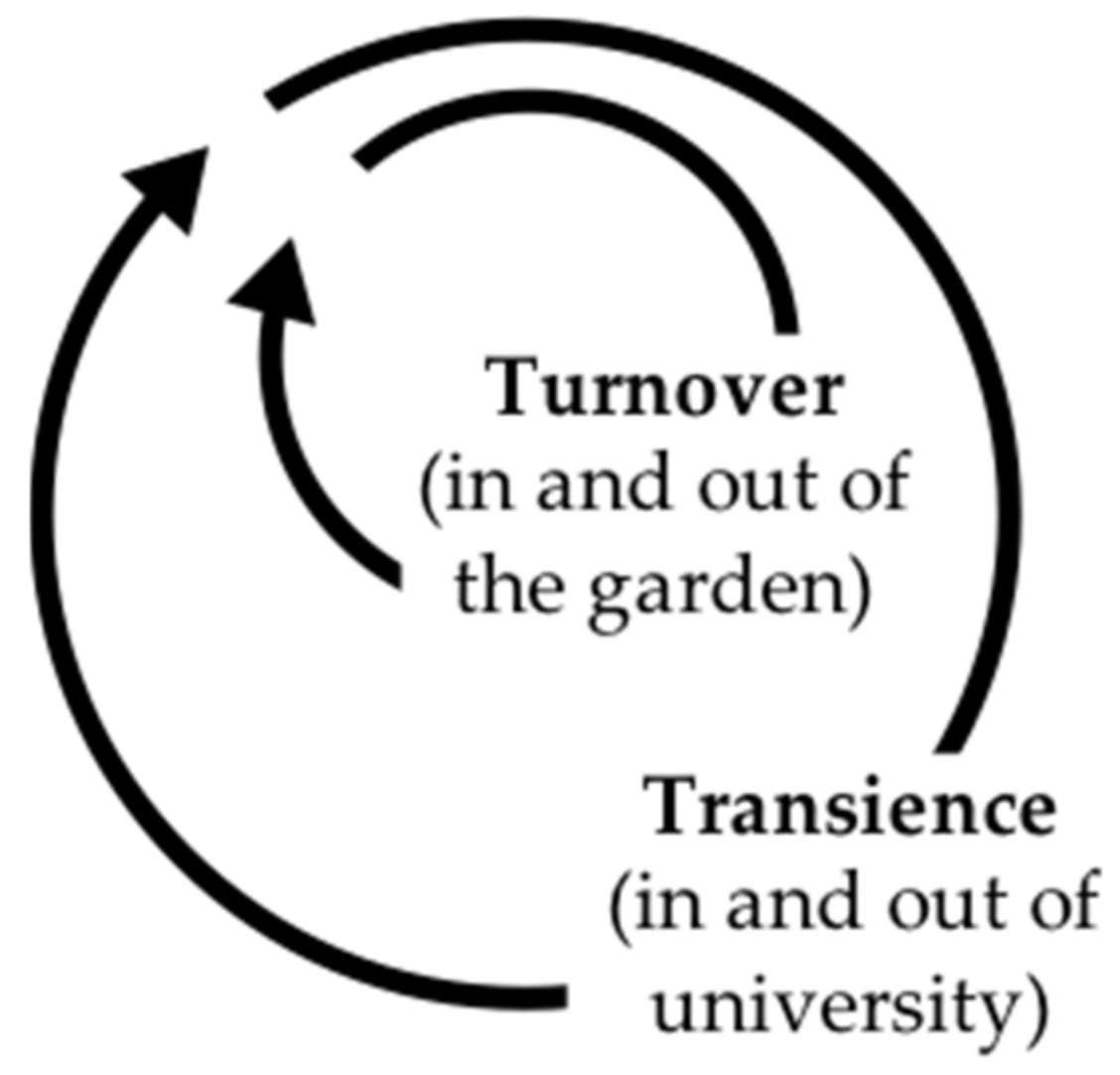


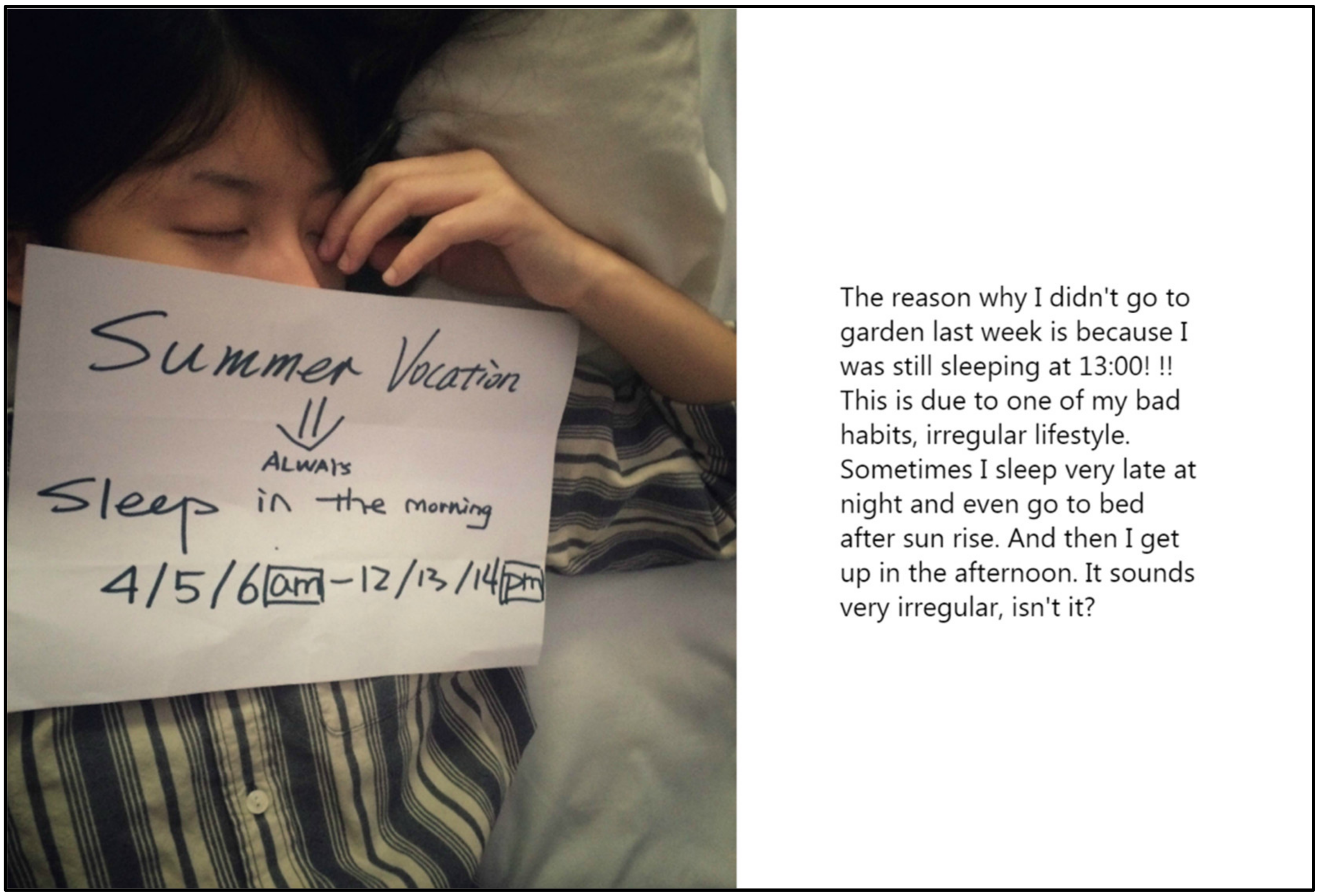
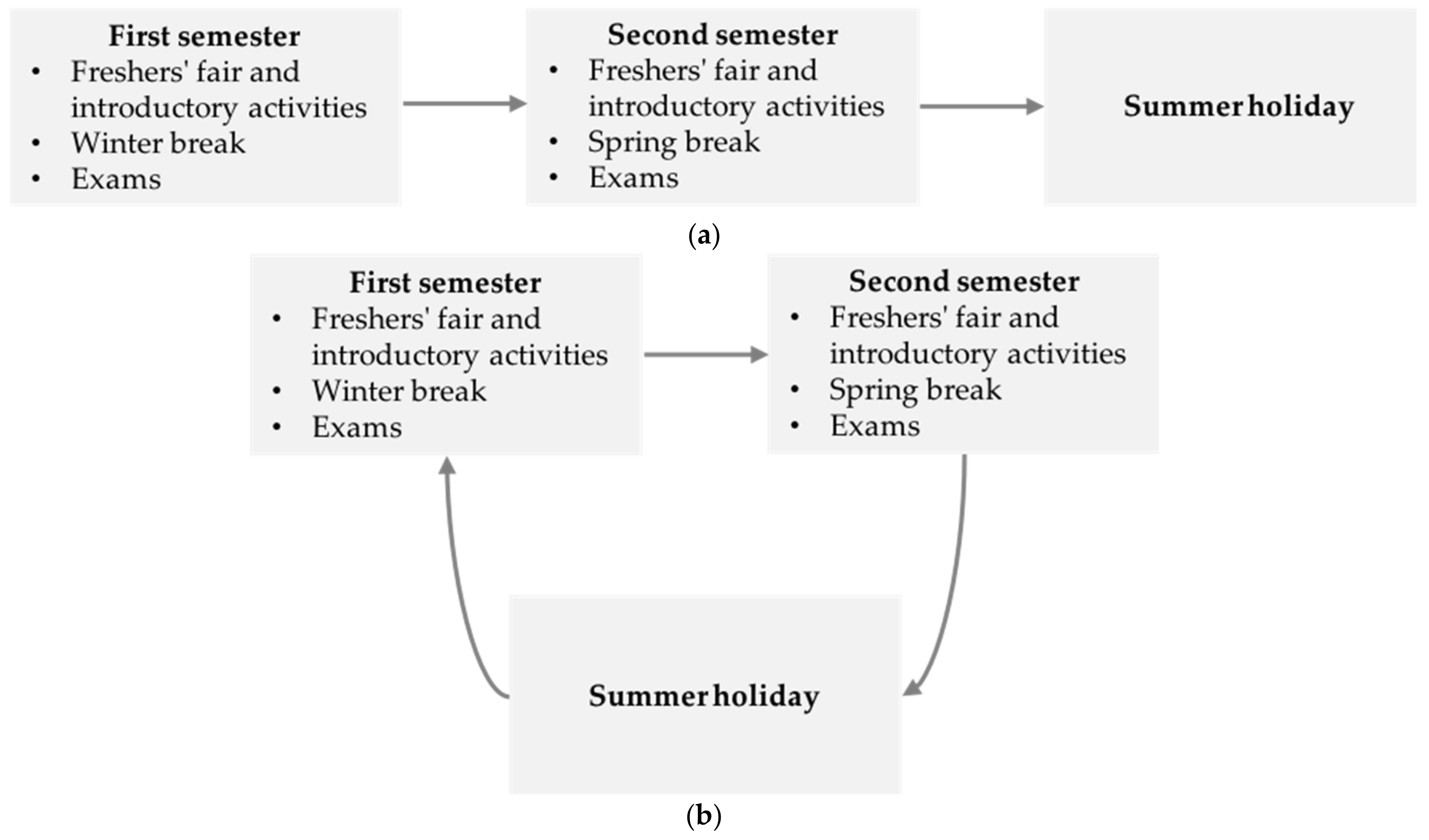
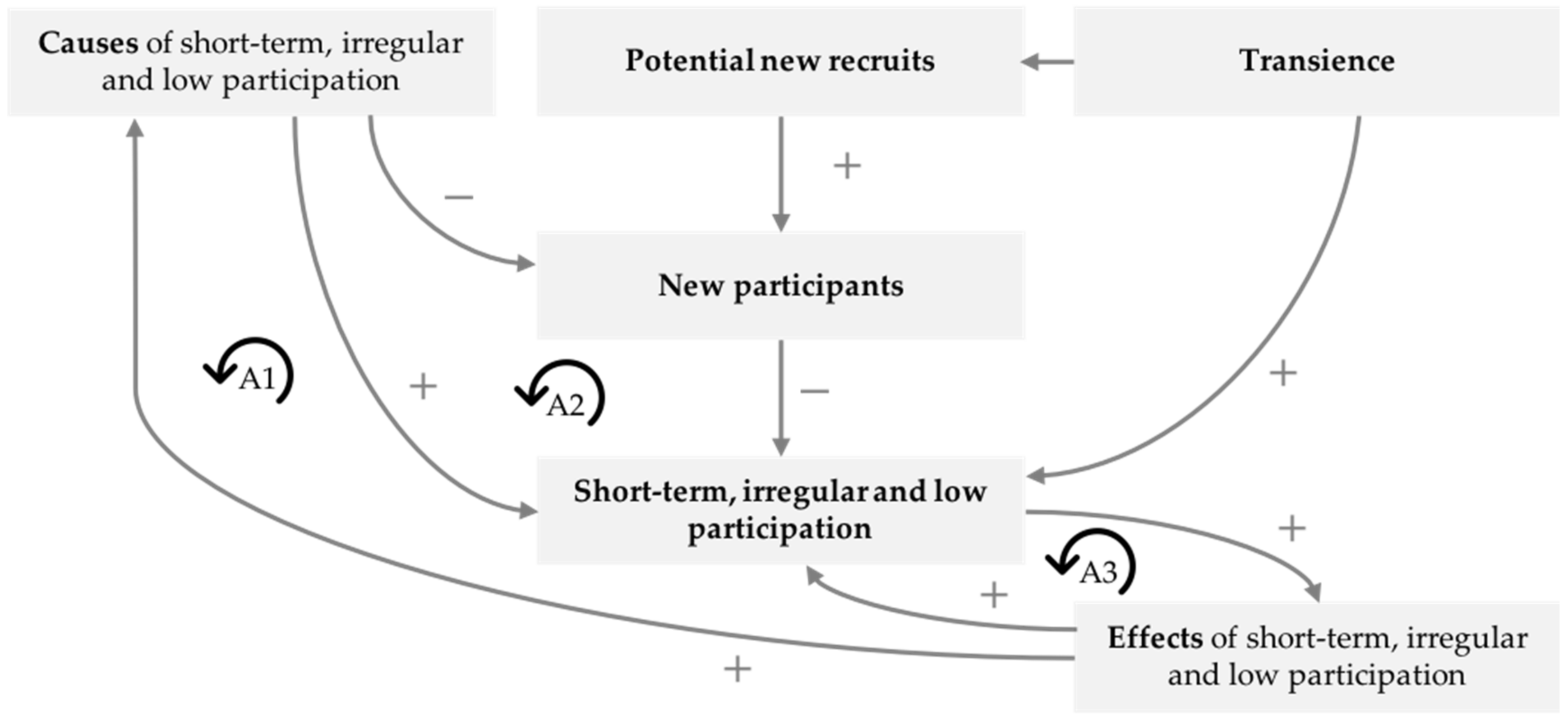
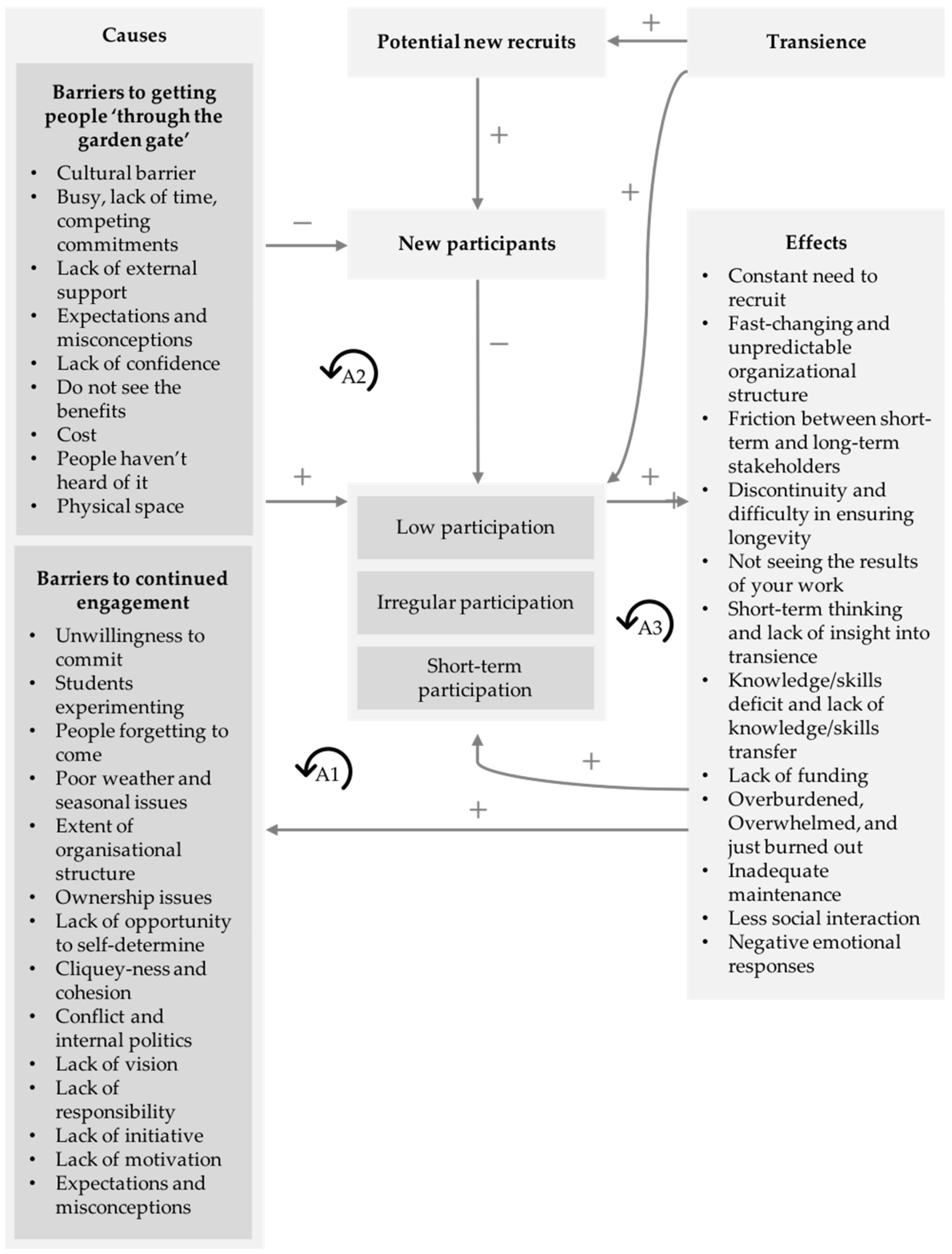
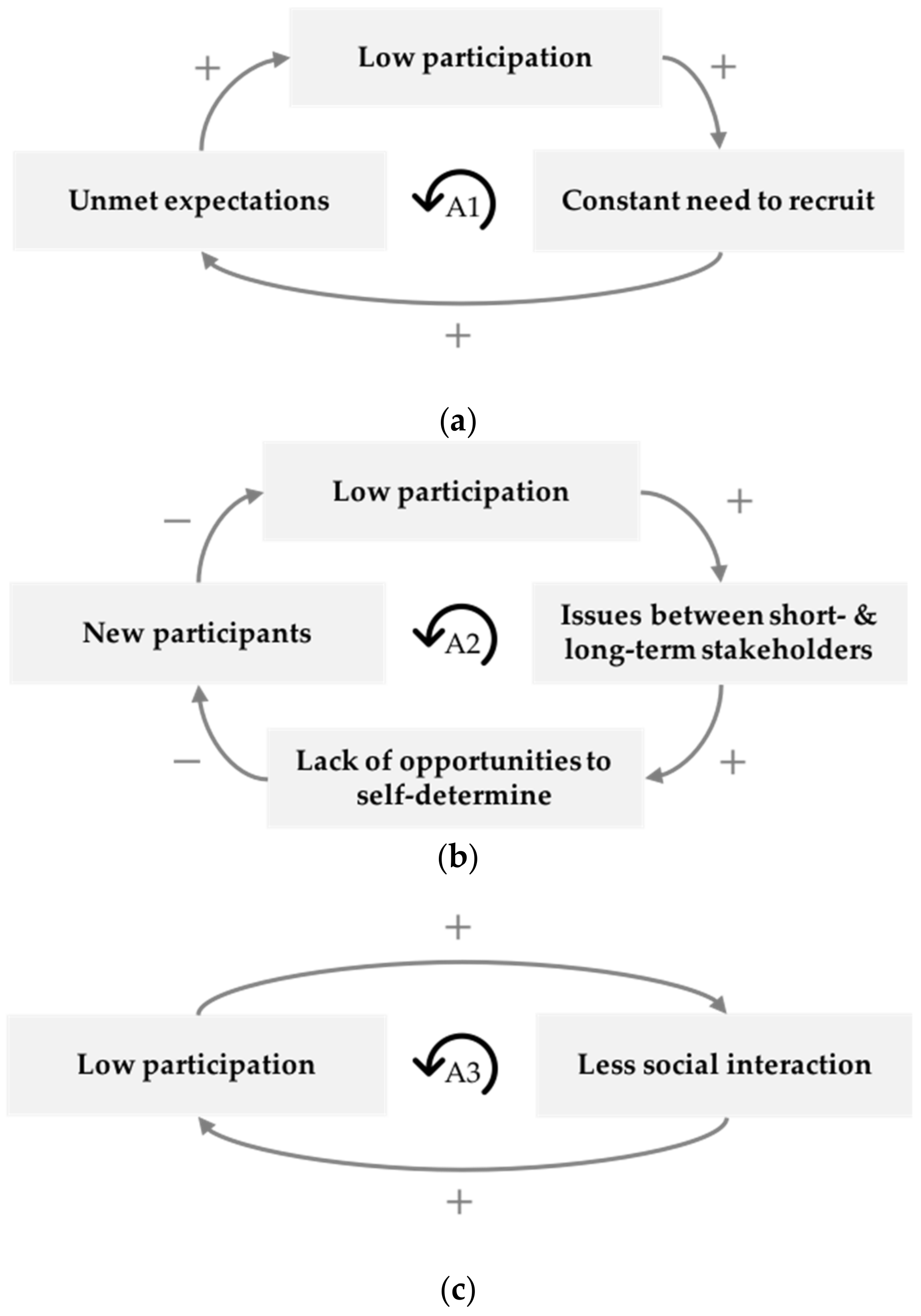
| Approaches to: | Temporary Organisations | Permanent Organisations |
|---|---|---|
| Knowledge | “Excellent domain for context-specific knowledge-creation” [33] (p. 1217) | Reduced reflexivity |
| Knowledge retention is a problem | More established knowledge management practices | |
| The orientation towards knowledge is exploratory | The orientation towards knowledge is exploitative | |
| Risk | Changes that result in risk are viewed positively as they present opportunities | Changes that result in risk are viewed negatively as they are a threat to the longevity of the organisation |
| Undertakes high-risk activity | Undertakes low-risk activity | |
| Lacks temporal consistence and therefore is more risky | Has temporal consistency and therefore has less risk | |
| Time | Linear, where tasks are oriented to “fulfil a one-off mission” [34] (p. 1530) | Cyclical, where “routines are established to deal with constantly (seasonally, monthly, daily, etc.) reoccurring tasks”) [34] (p. 1530) |
| Features | Keele University | Warwick University | University of Sheffield |
|---|---|---|---|
| Size of University | Approx. 10,000 students | Approx. 25,000 students | Approx. 30,000 students |
| Location of University | rural | rural | urban |
| Extent to which the Garden was Student-Led | Mainly undergraduate participants | Mainly undergraduate participants | Mainly undergraduate participants |
| Supported by a PhD student (the first author, Laycock Pedersen) | Supported by a PhD student | Limited postgraduate participation | |
| Negligible support from grounds staff | Some support from grounds staff (e.g., provision of compost) | Some support from grounds staff (e.g., provision of compost) | |
| Garden Characteristics | Eleven raised beds of approx. 10 m2, two of which run by students, the other 9 rented out to staff and campus residents | Roughly 18 raised beds (approx. 2m2), a polytunnel (approx. 15 m2), several of small plots and borders dug directly into the ground, and a shed | Six raised beds (approx. 3–4 m2 each), several beds dug directly into the ground (approx. 12 m2 total), a shed, a small glass greenhouse, and a pond |
| Located within a historical Walled Garden with a locked gate | Located behind student residences in a low-traffic area on campus | Located in between other university buildings and residences, next to an open green space | |
| Students had access to a large greenhouse run by the biology department |
| Types of Knowledge/Skills | Generalisable | Place-Based |
|---|---|---|
| Horticultural | e.g., how far apart to plant kale, how much sun tomatoes need | e.g., potato blight has recently affected one of the beds and therefore potatoes cannot be planted there, one of the beds drains faster than the other and therefore needs more water |
| Administrative/Interpersonal | e.g., the most strategic ways to recruit new participants, how to manage voluntary workload to avoid burnout | e.g., who to contact if you need compost delivered |
© 2019 by the authors. Licensee MDPI, Basel, Switzerland. This article is an open access article distributed under the terms and conditions of the Creative Commons Attribution (CC BY) license (http://creativecommons.org/licenses/by/4.0/).
Share and Cite
Laycock Pedersen, R.; Robinson, Z.P.; Surman, E. Understanding Transience and Participation in University Student-Led Food Gardens. Sustainability 2019, 11, 2788. https://doi.org/10.3390/su11102788
Laycock Pedersen R, Robinson ZP, Surman E. Understanding Transience and Participation in University Student-Led Food Gardens. Sustainability. 2019; 11(10):2788. https://doi.org/10.3390/su11102788
Chicago/Turabian StyleLaycock Pedersen, Rebecca, Zoe P. Robinson, and Emma Surman. 2019. "Understanding Transience and Participation in University Student-Led Food Gardens" Sustainability 11, no. 10: 2788. https://doi.org/10.3390/su11102788
APA StyleLaycock Pedersen, R., Robinson, Z. P., & Surman, E. (2019). Understanding Transience and Participation in University Student-Led Food Gardens. Sustainability, 11(10), 2788. https://doi.org/10.3390/su11102788




